Most of us are familiar with the white and yellow line markings on UK roads. Some of us however may wonder exactly what those red lines called red routes mean.
New drivers or foreign drivers in the UK often ask what are red routes and when were red routes introduced? Red routes were introduced in 1929 in London to aid in alleviating traffic congestion.
The red single or double red lines are placed on major arterial roads and generally impose stricter rules and regulations for stopping or parking than the more frequently seen single or double yellow lines.
This section explains the difference between single red lines, double red lines, red route parking, stopping and the Penalty Charge Notices (PCN) fines associated with parking on double red lines.
Single and double red lines
Red routes use single and double red lines just the same as the single or double yellow lines. Although red route rules are similar to those of the yellow, red route rules are often vehemently enforced which results in many thousands of PCN fines being issued each year.
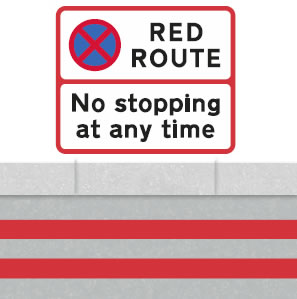
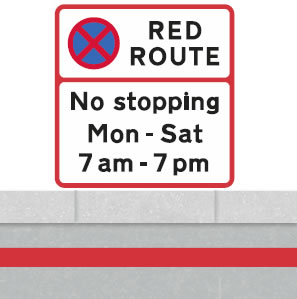
parking on Red Routes
Unlike double yellow lines, there are virtually no exceptions to red route parking on double red lines. No stopping, waiting, loading or picking up or setting down of passengers is permitted on red route double red lines.
Licensed taxis are permitted to drop off and pick up passengers on red route double red lines and disabled blue badge holders are permitted to pick up and set down disabled passengers on red route double red lines.
Parking on Single Red Lines
You are permitted to park on single red lines outside of the times displayed on the sign. Based on the single red line sign displayed, you may park here overnight from 7 pm through to 7 am and all day Sunday.
If stopping restrictions are in force, the restriction applies to the whole road, including the verge and footway. Single red line restriction times are shown on upright signs that face oncoming traffic.
Red route disabled parking
Unlike yellow lines, disabled blue badge holders must not park on a red route. A driver of a vehicle displaying a blue badge can stop to pick up or set down a disabled person only.
Red route PCN
Penalty Charge Notices (PCN) are issued to motorists that do not conform to the rules restricting them from stopping in a red route double red line area or if within the restriction times displayed on signs.
Red route rules are upheld strictly and many thousands of PCN are issued each year through CCTV alone. A PCN ticket can also be issued by local police traffic wardens, or the council’s own parking attendants.
parking fines
A red route parking fine is usually £100 – £130 and if paid within a certain time shown on the ticket, a discount will apply. This is usually in the region of 50% and if the fine is not paid within this time-frame, the full amount will be required to pay.
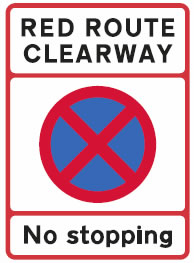
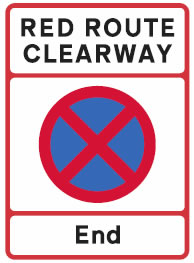
Red route signs
Certain red routes have upright signs without any road markings. These are designated “RED ROUTE CLEARWAYS”, where stopping for any purpose is prohibited at all times, except in designated and marked lay-bys. Unlike rural roads with 24 hour clearway in force, it is prohibited to stop on a red route clearway on the main carriageway, the verge and the footpath. Motorists entering the red route area from a side junction will be met with red junction lines to indicate they are entering a red route area.
Red route parking bays
Red route parking bays along the road are provided in certain areas for parking or loading. Red route parking bays are marked with a broken red or white line and the conditions that apply to each bay is indicated on upright signs that should also face oncoming traffic.
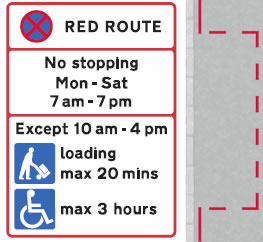
Red Route Parking bay broken red lines
A red route bay marked with red broken lines indicates that it is available for use for only part of the time that the red route “no stopping” rule applies. In this sign, the bay must not be used from Monday to Saturday between 7 am and 10 am and also not between 4 pm and 7 pm. In this example, the bay may be used for loading or unloading (max stay 20 minutes) and by blue badge holders (max stay 3 hours), during the times shown in the bottom panel.
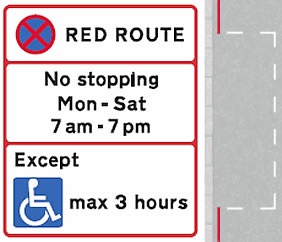
RED ROUTE PARKING BAY BROKEN White LINES
A bay marked with white broken lines means that it is available for use at all times that the red route “no stopping” rule applies. The upright sign shown in this example means that the bay is reserved for blue badge holders, with a maximum stay of 3 hours and can use the bay at any time.
Guides related to road markings and lines
Road markings theory test quiz
When you feel confident in your ability to understand road markings and lines, take the free road markings theory test quiz and test your knowledge.


Can I park just after a red route
Hi Maria,
Yes sure, providing there are no other parking restrictions on place.
what are the restrictions on single red routes, can I park on the side of the road that has a single red line?
Hi Dermot,
You are permitted to park on single red lines outside of the times displayed on the sign.
My car had a puncture on the front passenger wheel, i stopped in an emergency on a single red line, then drove the car with the puncture in a safe spot so that i can change the wheel, i got a pcn, can i appeal this
Hi Sharif,
Technically you can appeal it yes, but it’s really about obtaining proof. As you didn’t have any breakdown assistance attend and if it was only you at the scene, it’s your word against theirs. Ask to view the CCTV footage and hopefully this will show the incident and that you had to stop due to reasons out of your control.
Will I get a ticket if I stopped on a red route sign white box? No stopping Mon-Sat 7 am to 7 pm. 30 mins no return within 1 hour
Hi Mayur,
If you stopped in this area between Monday to Saturday, 7 am to 7 pm and there is CCTV in the area, there is a good chance. Or if you parked there outside of the no stopping restriction times for more than 30 minutes, or returned to park there again within 1 hour of leaving, you may also receive a ticket.
I want to park at 20.00 on a week night in kennington Road there’s a red line with 3 red box’s it says 7am to 7pm no parking so I presume I can park there at 8.00pm ?
Maria
Hi Maria,
You need to be careful with the parking bay boxes that are outlined in red. You can park in it during the times specified on the sign, but they are usually for unloading. Check what purposes you are permitted to park there, it should state this on the sign. Ideally you need to locate a parking box with a white outline and park there during the permitted time displayed on the sign.
I’m a taxi driver and dropped off a customer going to a hotel outside there was a layby with double red lines in. I’ve got a ticket from a company which the hotel says the road outside has nothing to do with them. My car had my its licence on display and even had my personal licence on display in the window. Should I pay the fine?
Hi Mark,
I would contact the company explaining that you had your licence on display and ask for the exact reason why they issued you a ticket.
I parked on a parking bay at night in a zip car you can not tell if its meant to be white or Red especially at night. I received a pcn notice 3 months later from zip car saying i am charged £160 plus £15 admin. What is my next move
Hi Lawrence,
I’m not entirely sure what your particular situation is, but I assume it’s to do with not receiving your ticket within 14 days, hence not being able to pay the reduced amount, or perhaps you wish to appeal the ticket.
I would contact Zipcar and ask why it’s taken 3 months. There’s also come advice on Citizen Advice about receiving tickets over the 14 day threshold.
I parked for less than 5 mins in red route all sign showed 20mins loading but where i Park just next to other cars it didn’t have that 20mins load time. At that time I didn’t notice, the sign wasn’t visible as there was scaffolding. I got a tick can I appeal?
Hello Shuma
If the parking signs were obstructed, then you do have a case to appeal. Best to take photographic evidence of where you were parked and of the obstruction.
I can’t find a clear answer for this anywhere: Can I park in a Red box on a red route, outside of the times shown on the sign? The example above shows Mon – Sat / 7am – 7pm. With this example, could I park in the red box from 7pm-7am without a fine?
Hi Chris,
So let’s look at the red route sign with the three sections and the parking bay surrounded by red dashed lines.
The top section tells you what it is, that is, of course Red Routes.
The middle section tells you what you are prohibited from doing, in this instance, you must not stop anywhere on the red route, including inside the bay, from Monday to Saturday, 7am to 7pm.
The bottom section provides an exception to this rule, and in this instance, you can load or unload for up to 20 minutes from between 10 am to 4 pm. In this time, drivers showing a disability parking permit can park in the bay for a maximum of 3 hours.
Restrictions only apply to the times shown, so yes, you can park in the bay from 7 pm to 7 am. If restrictions were in place 24/7, the sign would state no stopping at any time.
Recently I parked on one of those RED ROUTE signs that says “expect 10am to 4pm” and I get a ticket for being park there to get out of the car , so reallly I don’t understand the 10 am to 4 pm , and park there for many years like in Some other places with the same traffic sign .
What to do now , any advice ????
Hi Felix,
The second section of the sign under where it says RED ROUTE provides the prohibition to everyone. The only exception is in section 3 (the next one down), so you can park there between 10am and 4pm (depending on what times the sign shows) to specific people. This could be loading, unloading, disabled etc. So unless you are not loading, unloading or disabled (or whatever the sigh gives an exception to) then you’ll be prohibited from parking or stopping unless between those times unless you’re an exception.
Well I stop on the RED ROUTE sign that SHOWS ON THIS PAGE that is on the top and is a non stoping 7am to 7’pm with an expect 10 am to 4 pm Red route sign , 20 minutes loading 3 hours for disabled drivers, , I parked the from 13 pm less then 10 minutes and I been charged £80 to pay for
Is this right or wrong ??? Should I pay the fine or not ???
I think I did not commit any traffic offence , now I don’t know I parked there like in many others like that and never get a single ticket .
Are you registered disabled and displayed a badge or were you loading or unloading?
Hi there I enter the ILEZ about 2 weeks ago which I have paid at that about 9 pm and get back out from the ULEZ area on the following early morning on the next day at about 3.26am , and I’ve received a ticket , how can I get a ticket if I’ve paid to drive in the ULEZ zone ..
For how long does the ULEZ charge in active since you purchased it
Hi Felix,
I believe it’s midnight to midnight, hence why you received a ticket.
Hi,
Red route sign. No stopping Monday to Friday 7am-7pm. Except loading 20 minutes. Bays are white dotted line. One side of the bay double red the other one double yellow. How is this a red route? Also can the vehicle be parked on Saturday and Sunday in that bay?